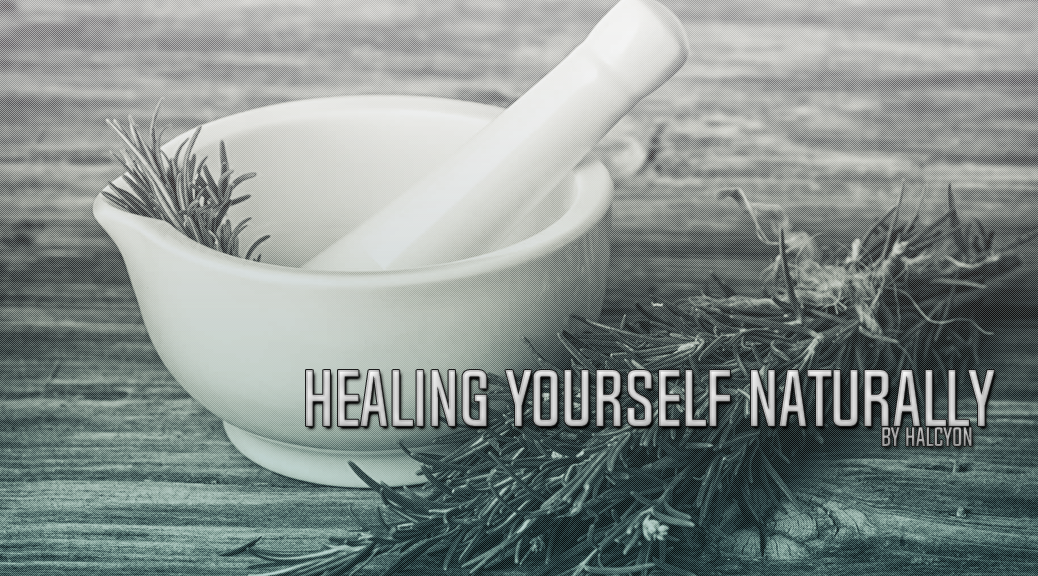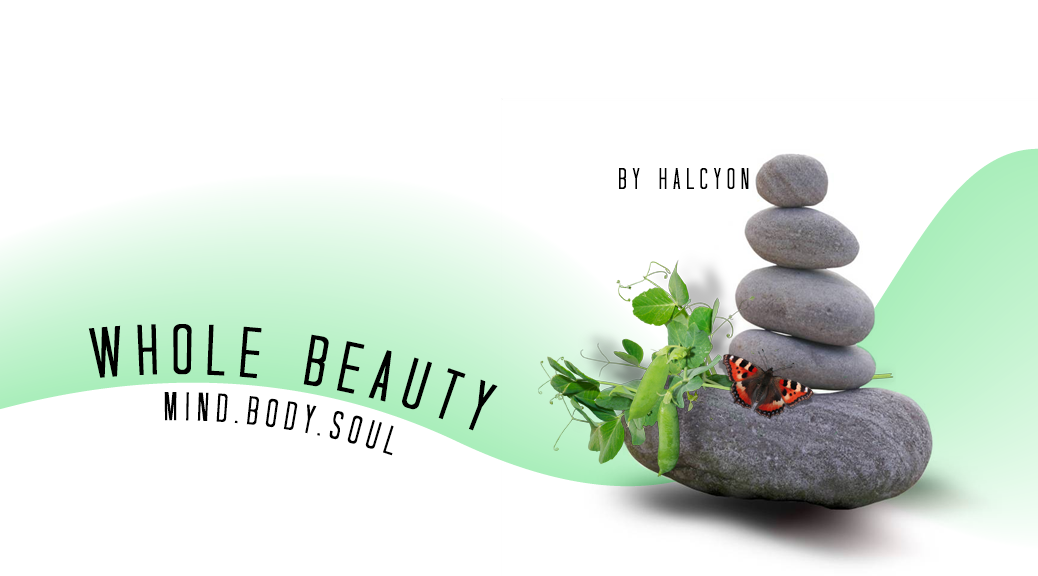By Halcyon
In this issue, Halcyon shows us how to make our own beauty products at home! While the majority of these recipes should be safe for anyone without allergies to their ingredients, some do include essential oils. Remember that essential oils should never be applied to the skin without being diluted first, and that some, such as citrus oils, can cause photosensitivity when exposed to sunlight. Always do your research first, and if you have questions or concerns, be sure to bring them up with your doctor or other health care provider!
DIY: Lotions and Potions and Scrubs, oh my!
This installment of Whole Beauty is all about Doing-It Yourself. Get in your kitchen, take out those mixing bowls, and get cracking! It really is very easy and a lot of fun. If you have kids, get them in on the action. You may want to do a test-run before you let them join in, or just read over the recipes and decide what your child can do.
These are not my own creations, though I have tweaked them a bit for what works for me. Pinterest is a treasure trove of ideas for DIYs. A lot of the time it is trial and error, but don’t give up. You will save a lot of cash by doing this at home, and most of all, you will know exactly what is going into your product. As someone who has very sensitive skin, I’ve had to learn to do it myself because I’ve had reactions to some very expensive products – even those said to cater to allergy-sensitive skin. But no more.
For those who need to budget like me, you may not be able to do this tomorrow. Plan it out, investigate the prices on items you may need, and just parcel it out. Sometimes you can strategise it for sales on Amazon (or wherever you may shop) and get great deals on all your DIY needs.
Here we go:
Lavender Lemonade for Migraine and Headaches
Ingredients
* 1 drop of lavender essential oil
* 6 lemons
* 1 cup of honey
* 12 cups of water
* 1 tbsp of raw honey for sweetness
Directions
1. Peel the lemons, and then squeeze them in a pitcher.
2. Add water, honey and one or two drops of lavender essential oil. Mix all the ingredients.
3. Store the drink in the fridge.
This is really very refreshing, and you will be amazed at how it seems to alleviate headaches. I am not sure of the reasons why, aside from lavender always having been a calming herb, but anything to help a migraine is awesome in my book!
Impurity Removing Face Mask
Ingredients:
* 2 tablespoons bentonite clay
* 3 capsules activated charcoal
* 3-4 teaspoons aloe vera
* 1-2 teaspoons shea butter
* 1.5 oz camomile tea
* 1 drop peppermint essential oil (optional)
* 1 drop eucalyptus essential oil (optional)
Directions:
* Start by brewing the tea
* Melt the shea butter in a double boiler
* When the tea is ready and the shea butter is completely melted, mix them together
* Mix the bentonite clay and the activated charcoal in a seperate container
* Add the clay and charcoal mix to the shea and tea mix and stir
* Add the aloe vera and essential oils and continue to mix well
* Store in an air-tight container
* To use: Apply all over face and keep on for about fifteen minutes. Wash off well and admire your soft skin!
Homemade Hydrating Lotion
Ingredients:
* A food processor
* A double broiler
* 1 cup room temp. herbal tea (I like the chamomile variety for this)
* 1/2 cup coconut oil
* 1/4 cup shea butter
* 3/8 cup sweet almond oil
* 1/8 cup extra virgin olive oil
* 4 tbsp beeswax pastilles
* 1-2 tsp total of essential oils of your choice. I used the following Doterra oils: Lavender Oil, Helichrysum Flower Oil, and Rose Flower Oil.
Three Easy Steps:
Step One: Brew
* Brew the tea. Boil the water, steep the tea, and bring to room temperature.
Step Two: Melt
* In the double boiler, melt the butters, oils, and beeswax together. Do not add the essential oils yet.
Step Three: Emulsify
* Pour the melted oils into the food processor and lock the lid. Turn the food processor on, and slowly pour 1 cup of herbal tea into the mixture. It should begin to emulsify. Leave it running for another thirty seconds after you’ve poured in all the tea. You may need to stop the food processor and scrape the sides to blend completely. Add the essential oils of your choice and blend for another thirty seconds.
Storage and expiration:
* This recipe will make 2-3 cups of lotion. If you don’t want this much lotion, cut the recipe in half. The lotion should keep pretty much indefinitely in the fridge without added preservatives. You can put it into a couple of small containers holding a few ounces and then just refill. I suggest if you live in a hot climate like I do, you keep a larger jar in the fridge and refill from there. You may have to let it come to room temp. If it gets too hot, it might lose its consistency.
* The lotion goes on cool and smooth and absorbs quickly, leaving your skin nourished and hydrated. It smells amazing and does not leave a greasy residue or shine on your skin. It is completely safe to use on your kids. (Heck, you can even eat it, but I don’t think it would taste very good!)
Facial Moisturizer
* 1 cup aloe vera gel (This bit is important. In the comments, a few people have tried to substitute plain Aloe juice, or home-made gel, but it doesn’t have the stabilizing properties needed. It has to be a gel.)
* 3/4 ounce (by weight) beeswax – I buy mine in a bar and grate it. You can buy it in pellets, too – make sure you get the kind for cosmetics, not candles. Some of the latter come scented. The beeswax is in there as another stabilizer. When you make an emulsion like this, you are essentially mixingÃÂ water and oil – two things that don’t mix. Instead, they will sit next to each other. Tiny blob of oil, then tiny blob of water, tiny blob of oil, etc. When the lotion separates, it is because those tiny blobs touch others of the same type and create a bigger blob of oil or a bigger blob of water. This causes a chain reaction and the mixture separates. I’ve added the wax because it will blend with the oils and make them less fluid (since it is solid at room temp). Hopefully less fluidity will mean less separation.
* 1/4 cup almond oil
* 1/4 cut coconut oil
* 10 drops of your favorite essential oil (Please note that essential oils are serious business. Always take into account the oil you are using and its affects. I like grapefruit, but it can increase sun sensitivity. Also, be sure to test the oil on your skin ahead of time to note any allergic reactions, as well as researching whether they may react with your medications or medical conditions.)
* Chocolate/soap melter or double boiler
* Blender
Directions:
This moisturizer has been one of the most popular posts on the site for over a year! In that time, I’ve made this recipe several more times, and I’ve talked to many of you about your tips and tricks. I’ve assembled the most common into a FAQ at the bottom of the page. Check it out!
1. Start by melting the beeswax and coconut oil in the almond oil
2. Pour the melted oils into your blender and walk away. It is super-duper essential that this stuff gets cool before you start to blend. There is no getting around this. For me it took about an hour and fifteen minutes. If you don’t let it cool, it separates later, which is gross. Trust me.
(Note: Some readers have had better experiences in blending if the oils are just-barely-warm, and the blender/aloe mixture is also just-barely-warm. Try it and let me know what happens!
3. Mix the essential oil into your cup of Aloe Vera Gel.
4. Fire up the blender. Slowly pour the aloe vera gel into the blender as it whips. It will transform from a thick oil to a light and fluffy, more lotion-like texture. The first time I did this, I had to call my husband into the room to look – it’s for-real lotion!
5. That’s it! You’ve made your own facial moisturizer! Store some in a small container for your vanity and put the extra in the fridge. Keep in mind that lotion has a shelf life. Don’t use anything that looks/smells/feels wrong.
DIY Lotion Frequently Asked Questions:
If the lotion fails to mix correctly, try these approaches:
* Be sure to scrape the bottom of your blender several times during the blending step. Sometimes oils and wax sink down there and it will cause a watery consistency in the lotion.
* Add the aloe to the oils ever so slowly. We are creating an emulsion, mixing two items that can’t be mixed. We have to do it slowly for even distribution.
* Some have suggested making sure the oils and the aloe mixture are at the same temperature and a little above room temperature for optimum mixing. Perhaps wait until the oils are just warm to the touch, and heat the aloe gel to the same (probably about ten seconds in the microwave) before blending. Avoid cold aloe gel or blending in a cold blender.
If after all this, the lotion comes out slimy or separating, transfer into a bowl with a hand mixer or a stand mixer and whip the ever-loving daylights out of that bad boy! Additionally, you can use it as-is. It’s still a great moisturizer; it just doesn’t look as pretty. This is the price we pay for avoiding chemical stabilizers and preservatives
Whipped Magnesium Lotion
Ready-made magnesium lotion is not cheap. Prices on Amazon range from $9 to $20 for a small 8oz bottle. This is why I chose to make my own magnesium lotion, and have loved the results with this recipe.
Magnesium Lotion Supplies:
* 1/2 cup magnesium flakes
* 3 tbsp boiling water
* 1/4 cup cocunut oil
* 2 tbsp beeswax pastilles
* 3 tbsp shea butter
* 1 quart mason jar
* 2 coffee mugs
* Immersion blender
* Essential oils for scent (optional – I like lavender and rosemary together)
Magnesium Lotion Directions:
1. Measure the magnesium flakes into a mug. Fill another mug halfway with water and microwave on high until it is boiling, abut two to three minutes. (Alternatively, you can bring water to boil on the stove.)
2. Measure 3 tbsp of boiling water into the mug with the flakes. Stir until the flakes are dissolved and set aside.
3. In the quart mason jar, measure coconut oil, beeswax and shea butter. Place the jar in a small pan filled with one inch of water. Place it on the stove and turn the heat to medium high.
4. Allow the solids to melt, swirling the jar occasionally if necessary. (Be sure to wear an oven mitt.)
5. When everything inside the jar is melted, remove it from the pan and let it cool for about five minutes.
6. Pour the dissolved magnesium into the quarter mason jar. If it solidifies upon contact, that’s ok. Add essential oils (if using). Place the immersion blender at the bottom of the jar and blend everything together well, moving the blender up and down along the sides of the jar as necessary to incorporate the ingredients.
This makes about eight ounces of lotion. Store at room temperature for up to two months.
Home Made Healing Salve With Five Ingredients
Ingredients:
2 tbsp beeswax pellets
2 tbsp shea butter
1/4 cup coconut oil
1/2 cup sweet almond oil
15-20 drops therapeutic grade essential oils (I used lavender essential oil)
4 oz. tin containers
Directions:
1. Combine beeswax, shea butter, coconut oil, and sweet almond oil in a glass measuring jar.
2. Place the measuring jar in a small pot on the stove. Fill the pot about one-quarter of the way with water.
3. Bring your water to a boil over medium heat.
4. Stir occasionally until the contents of the jar melt (about fifteen minutes), then add your essential oil.
5. Carefully pour hot salve into small tin containers.
Warning: Use caution – the homemade healing salve mixture will be very hot!
6. Let your salve set overnight.
7. Enjoy!
DIY Cellulite Scrub
Ingredients:
1/2 cup coffee grounds
1/4 cup sugar
1/4 cup olive oil
Directions:
* Mix ingredients together in large bowl
* Apply in a circular motion to targeted areas on the body for approximately five minutes
* Rinse off with warm water
* Pat dry with a towel
The caffeine and antioxidants in the coffee grounds stimulate and dilate your blood vessels, which tones and tightens the tissue. The sugar further helps exfoliate, while the olive oil gives a big dose of hydration and plumping.
Now, you finally have something to do with the grounds after you brew yourself a cup of fresh coffee!
Homemade Tiger Balm
Ingredients:
1/2 cup olive oil
2 tbsp beeswax
1.5 tbsp menthol crystals
30 drops camphor essential oil
20 drops eucalyptus essential oil
10 drops cajuput essential oil
10 drops cassia essential oil
5 drops clove essential oil
Directions:
1. Fill a medium sized pot half way full with water.
2. Place a glass purex bowl in the water.
3. Add olive oil, menthol crystals and beeswax.
4. Turn stove top to medium heat.
5. Once the beeswax is melted, remove from heat.
6. Add essential oils.
7. Pour into 4 ounce jar.
I use Mountain Rose Herbs for everything. I also use Amazon for beeswax unless I stock up at the Rennaissance Festival for some good stuff there.
DIY Homemade Makeup Remover Pads
Ingredients:
* 1 quart wide mouth jar
* 2 tbsp of coconut oil
* 2 squirts of tear-free baby wash
* 2 cups of purified water
* 2 packages of cotton pads
* Optional: Tea tree essential oil (will help with acne, but should not be used on the eyes) or frankincense essential oil (will help rejuvenate the skin and decrease the appearance of fine lines and wrinkles)
* Microwaveable bowl
Instructions:
1. Mix 2 tablespoons of coconut oil, 2 squirts of tear-free baby wash, and 2 cups of purified water.
2. Microwave in ten to twenty second increments until melted and well blended.
3. Place about fifty cotton pads in you quart jar.
4. Pour the liquid mixture over the pads in the jar. Press the pads down to help soak up the liquid. Add more pads to fit, again pressing down.
5. Secure lid tight and keep in a dry, cool place.
6. Use the pads to remove your makeup daily.
Honey Sugar Scrub
Honey is a humectant. It also contains anti-bacterial properties tat help get rid of bacteria on your skin that can cause acne and other skin imperfections.
Sugar is a natural source of glycolic acid, an alpha-hydroxy acid (AHA) that penetrates the skin and breaks down the bonds of dead skin cells, encouraging cell turnover and generating fresh skin layer.
Ingredients:
* 1 tbsp raw honey
* 1 tbsp white/brown sugar
* 1 tbsp of olive oil (optional)
* Your favorite essential oil (optional)
Black Head Clearing Scrub Using Salt
Benefits:
* Salt helps to reduce excess oil on the skin. It is also a great natural scrub to get rid of blackheads thanks to its exfoliating properties.
* Rice flour, just like salt, exfoliates the upper layer of skin, exposing blackheads and making them easy to remove with scrubbing.
* Lemon juice is a natural astringent and loosens the blackheads.
* Lemon juice also has anti-microbial and skin cleansing properties that inhibit the growth of bacteria in pores while cleansing the skin.
* This scrub helps control oil/sebum secretions, thanks to the lemon, which balances the sebaceous glands.
* The exfoliating properties of this scrub can, with regular usage, eliminate not just blackheads, but whiteheads, too!
* The scrub can be used under the lips, on the nose and anywhere else to where you get blackheads.
Ingredients:
* 1 tsp salt (table salt, pink salt or black salt)
* 1-2 teaspoons of rice flour
* The juice of half a lemon.
Directions:
1. Place 1 teaspoon of salt in a small bowl.
2. Add 1-2 teaspoons of rice flour and mix the dry ingredients well.
3. Add in juice of half a lemon.
4. If using essential oil, add and mix well. My favourite is tea tree oil, as it helps me to get rid of acne on my face and some ingrown hair bumps on legs. You can add lemon essential oil (as it has the skin lightening ability and controls sebum production), or lavender essential oil to get relief from dry skin.
If you feel the scrub is too dry, you can add more lemon (or, if you have sensitive skin, you can add in water to achieve the desired consistency). Mix everything well and apply on your nose or any area that is prone to blackheads. You can first wash your face with warm water to open the pores and soften the blackheads. Let it stay on for a few minutes, then scrub thoroughly yet gently for another three to four minutes. Rinse it off and moisturize.
Store any remaining scrub in an airtight container. You can adjust the proportion according to your need of use.
Alright! That’s it for now. I hope you might find some uses for these DIYs, and that it will get you experimenting and having fun while saving money, along with the knowledge you are using good stuff on your skin.




